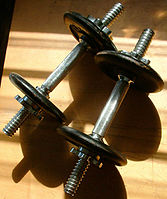
Photo from wikipedia
ABSTRACT We examined the relationships between heights of different vertical jumps and isometric single-joint strength characteristics of ankle, knee, hip, and trunk joints in young male soccer players (n =… Click to show full abstract
ABSTRACT We examined the relationships between heights of different vertical jumps and isometric single-joint strength characteristics of ankle, knee, hip, and trunk joints in young male soccer players (n = 117). The highest peak torque and rate of torque development (RTD) outcomes were in low to moderate correlation with jump heights (r = 0.25–0.50). The correlations were generally higher for bilateral than unilateral jumps. Linear regression models accounted for 33–35% and 24.5 of the variance in bilateral and unilateral jump height, respectively. Hip extension peak torque, ankle RTD and trunk lateral flexion peak torque were most consistently included in the regression models. Our results suggest the that single-joint isometric testing does not seem to be useful to detect weaknesses related to vertical jump performance. The relative importance of individual lower limb joints for vertical jumping seems comparable. Trunk strength should not be neglected as the determinant of jumping performance.
Journal Title: Measurement in Physical Education and Exercise Science
Year Published: 2021
Link to full text (if available)
Share on Social Media: Sign Up to like & get
recommendations!